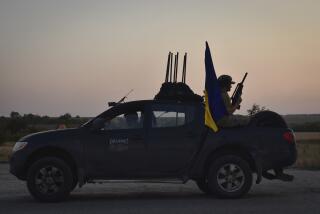Traffic Flows Over Bridge Into Bosnia
LONCARI, Bosnia-Herzegovina — As combat engineers worked to strengthen a temporary pontoon bridge over the Sava River, more U.S. Army tanks and other vehicles poured from staging points in Croatia into Bosnia on Monday. An additional 125 vehicles were expected to cross today.
As traffic continued to roll, Army engineers had to dump several more tons of gravel to stabilize the muddy approach ramp to the bridge, which had softened into a quagmire after temperatures rose above freezing for the first time in several days.
“The bridge is holding up well,” said Coast Guard Lt. Cmdr. Jim McPherson.
Earlier in the day, several hundred soldiers who had crossed the Sava on Sunday awoke from a frosty night spent in tanks and tents, eager for their first real look at the country that will be their home for the next year.
“It’s just war-torn, barren and plain,” said Pvt. Shannon Eads, 22, a Dallas native who serves as a medic. “Well, if I get shot here, at least I get to go home.”
For some soldiers, it was as though they had leaped into an enormous abyss, severing links to their own worlds. Above all, they are now in a place so pitted with mines that it is best to walk in someone else’s footprints and to drive only the main roads, hoping not to skid off.
The troops must assume that nothing is safe; in this country dotted with millions of mines, a mental slip could be fatal.
About 400 soldiers arrived here Sunday afternoon in the first of what will be numerous deployments as U.S. forces gradually build up to 20,000 in the North Atlantic Treaty Organization-led peacekeeping mission. But the precious hours of remaining daylight were consumed with pitching tents and erecting camps, so many soldiers waited until Monday morning to check out the land they have heard so much about.
Spc. Lacy Locklear, 22, a North Carolina native, sat in the hatch of his Bradley fighting vehicle, making a brew of instant coffee and instant cappuccino on a camping stove, when a convoy appeared. It was combat engineers dragging the twisted metal carcass of a Humvee that hit a mine Saturday--the vehicle driven by Spc. Martin John Begosh, the first American mine casualty of the peacekeeping mission.
Army doctors said Monday that the 23-year-old military policeman, who suffered leg and foot injuries, continued to make good progress, but soldiers who saw the Humvee seemed to flinch inwardly while outwardly bracing. “It was like, well, that’s what can happen if you hit a mine,” Locklear said.
As Locklear had left Croatia to cross the Sava, a chaplain blessed his Bradley fighting vehicle.
“That’s when I knew we were really here,” Locklear said. “I made myself become even more aware of my surroundings. I stepped it up another level.”
New Year’s Day appeared quiet in Bosnia-Herzegovina, except for one reported incident in the southern city of Mostar. Croatian police there shot at a car with license plates from the Muslim half of the city, killing Alen Muftovic, an 18-year-old Muslim man.
Muftovic was with three other young men who drove into the Croat-held side of town. Croatian police fired at the car after it failed to stop when they chased it, the Associated Press reported. The incident is likely to heighten tensions further in the divided city.
For American soldiers in Bosnia, New Year’s Eve was neither easy nor festive. Troops had been warned that local residents often fire weapons to usher in the new year. But even so, the gunfire made Locklear uneasy. He and 30 other soldiers had moved into a key American checkpoint surrounded by shelled houses outside the tiny town of Loncari.
“A lot of people were really nervous, including myself,” said 2nd Lt. Brian Hittner, a 23-year-old Nebraska native.
Close to midnight, the sky was filled with lights from tracer rounds.
“It was beautiful at first,” said Spc. Kevin Keith, a 27-year-old Arkansas native who joined the Army eight years ago. “There were orange tracers and bright yellow tank rounds.”
Then Keith heard what sounded like shots landing in the mud where he stood. That sound was followed by a ping ping ping noise that sounded like the bullets were hitting the military vehicles.
“I had no worries about them hitting me,” he said. “After all, there’s a guy who got hit by a mine and he survived--what are the odds of me getting hit by a little bullet?”
Later that night, when given the choice of sleeping in his vehicle or in the tent, where soldiers had fired up a stove and lined the floor with bricks and slabs of concrete, Keith opted for his vehicle.
“It’s a little thicker than a tent,” he said.
Indeed, most soldiers chose to sleep in armored vehicles. Hittner, who slept in the tent, was an exception. He used his flak vest as a blanket.
More to Read
Sign up for Essential California
The most important California stories and recommendations in your inbox every morning.
You may occasionally receive promotional content from the Los Angeles Times.










